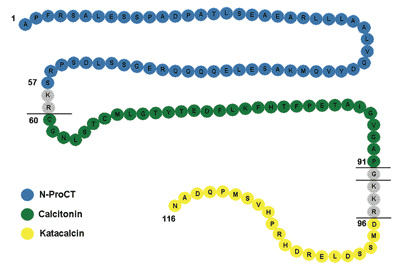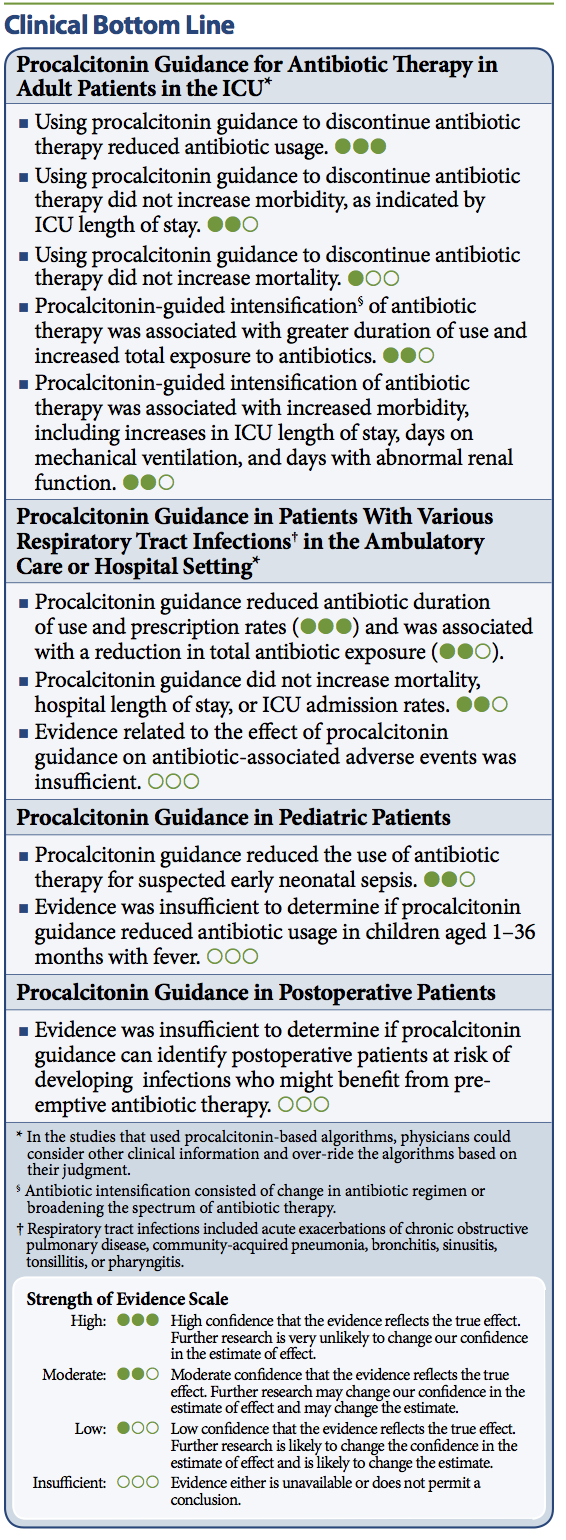
Procalcitonin之前也有跟各位介紹過:檢驗數值~PCT
[Free full-text Clinician Summary online]
[EXCERPTS]
Background Information
Several serum biomarkers have been identified in recent years that have the potential to aid the diagnosis of local and systemic infections, differentiate bacterial and fungal infections from viral syndromes or noninfectious conditions, prognosticate outcomes, and ultimately guide management, particularly antibiotic therapy. Among these biomarkers, procalcitonin is the most extensively studied and is often used with algorithms to guide care in association with clinical impressions.
Some evidence indicates that procalcitonin, when compared with other biomarkers, is more specific for bacterial infections, with serum levels rising early after the onset of infection and falling rapidly as the infection resolves. In systemic bacterial infections, including sepsis, procalcitonin levels are generally ≥0.5 ng/mL, with higher levels associated with severe disease. In patients with suspected respiratory tract infection, a cutoff of >0.25 ng/mL is predictive of a bacterial infection, while a level <0.25 ng/mL signals resolution of the infection. The cutoff level of procalcitonin to identify postoperative patients with infection may be higher than that used for other patient groups due to cytokine release during surgery. In neonates, a nomogram accounting for the time from birth in hours is recommended for assessing procalcitonin cutoffs.
Clinical Bottom Line
Procalcitonin Guidance for Antibiotic Therapy in Adult Patients in the ICU*
- Using procalcitonin guidance to discontinue antibiotic therapy reduced antibiotic usage. [Evidence: High confidence]
- Using procalcitonin guidance to discontinue antibiotic therapy did not increase morbidity, as indicated by ICU length of stay. [Evidence: Moderate confidence]
- Using procalcitonin guidance to discontinue antibiotic therapy did not increase mortality. [Evidence: Low confidence]
- Procalcitonin-guided intensification§ of antibiotic therapy was associated with greater duration of use and increased total exposure to antibiotics. [Evidence: Moderate confidence]
- Procalcitonin-guided intensification of antibiotic therapy was associated with increased morbidity, including increases in ICU length of stay, days on mechanical ventilation, and days with abnormal renal function. [Evidence: Moderate confidence]
Procalcitonin Guidance in Patients With Various Respiratory Tract Infections† in the Ambulatory Care or Hospital Setting*
- Procalcitonin guidance reduced antibiotic duration of use and prescription rates [Evidence: High confidence] and was associated with a reduction in total antibiotic exposure. [Evidence: Moderate confidence]
- Procalcitonin guidance did not increase mortality, hospital length of stay, or ICU admission rates. [Evidence: Moderate confidence]
- Evidence related to the effect of procalcitonin guidance on antibiotic-associated adverse events was insufficient.
Procalcitonin Guidance in Pediatric Patients
- Procalcitonin guidance reduced the use of antibiotic therapy for suspected early neonatal sepsis. [Evidence: Moderate confidence]
- Evidence was insufficient to determine if procalcitonin guidance reduced antibiotic usage in children aged 1–36 months with fever.
Procalcitonin Guidance in Postoperative Patients
- Evidence was insufficient to determine if procalcitonin guidance can identify postoperative patients at risk of developing infections who might benefit from pre-emptive antibiotic therapy.
________________________________________
* In the studies that used procalcitonin-based algorithms, physicians could consider other clinical information and over-ride the algorithms based on their judgment.
§ Antibiotic intensification consisted of change in antibiotic regimen or broadening the spectrum of antibiotic therapy.
† Respiratory tract infections included acute exacerbations of chronic obstructive pulmonary disease, community-acquired pneumonia, bronchitis, sinusitis, tonsillitis, or pharyngitis.
Strength of Evidence Scale [available online]






 留言列表
留言列表
 線上藥物查詢
線上藥物查詢 